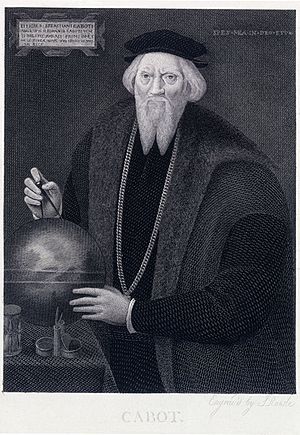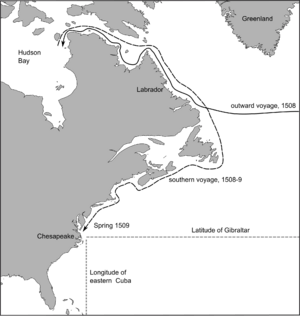Sebastian Cabot (explorer) facts for kids
Quick facts for kids
Sebastian Cabot
|
|
|---|---|
| Sebastiano Caboto | |

Sebastian Cabot in his old age
|
|
| Born | c. 1474 |
| Died | c. December 1557 (aged c. 83) |
| Other names | Sebastiano Caboto, Sebastián Caboto |
| Spouse(s) | Joanna, Catalina de Medrano |
| Parent(s) | John Cabot and Mattea Cabot |
Sebastian Cabot was a famous Venetian explorer. He was probably born in the Venetian Republic around 1474. Sebastian was the son of the well-known explorer John Cabot and his wife Mattea.
After his father passed away, Sebastian started his own exciting journeys. He searched for the Northwest Passage through North America for England. Later, he sailed for Spain, exploring South America. There, he traveled along the Río de la Plata and built two new forts.
Contents
Early Life and First Voyages
People have different ideas about where and when Sebastian Cabot was born. Some say he was born in Venice, while others say Bristol, England. What we know for sure is that he was the son of John Cabot, a Venetian citizen. His mother was Mattea Caboto, also from Venice.
Sebastian, along with his older brother Ludovico and younger brother Santo, was mentioned in King Henry VII's royal papers in 1496. These papers allowed their father to go on expeditions across the Atlantic Ocean. In 1497, John Cabot sailed from Bristol on a small ship called the Matthew. He reached the coast of a "New Found Land," which historians believe was either Newfoundland or Nova Scotia.
A Possible Early Journey (1494)
Sebastian Cabot's famous map of North America, published in 1544, has an interesting handwritten note. It claims that he and his father discovered North America in 1494. This was three years before his father's well-known voyage.
The note describes the land as "prima terra vista" (first land seen). It mentions a large island named Saint John, discovered on Saint John's holiday. The text also talks about the animals there, like white bears and very large deer. It also describes many fish, including plaices, salmons, and lots of cod.
Historians wonder if this 1494 date is correct. It might have been changed later for political reasons. At the time, Spain and Germany were funding Cabot. They might have wanted to show that the first trip to North America was earlier and funded by them, not by England or France. If the date is correct, it means the Cabots explored North America on their own before working for England.
Working for England and Spain
In 1504, Sebastian Cabot led an expedition from Bristol to the New World. He used two ships, the Jesus and the Gabriel. They brought back salted fish, showing that these trips were partly for business. In 1505, King Henry VII gave Cabot a yearly payment for his services in finding new lands.
From 1508 to 1509, Cabot led a journey to find a Northwest Passage through North America. This was a sea route connecting the Atlantic and Pacific oceans through the Arctic. He reached very cold areas with icebergs. He reported finding an open water passage but had to turn back. Some say he might have reached the entrance of Hudson Bay.
After this, Sebastian sailed south along the east coast of North America. He passed the rich fishing areas off Newfoundland. He continued until he was near the latitude of Gibraltar, close to what is now Chesapeake Bay. When he returned to England, King Henry VII had died. The new king, Henry VIII, was less interested in exploring new lands.
By 1512, King Henry VIII hired Cabot as a mapmaker. That same year, Cabot went to Spain and became a captain for King Ferdinand V. Cabot hoped Spain would support more big explorations. However, King Ferdinand died, and Cabot returned to England.
In 1521, Cabot tried to organize another English voyage to North America. He had support from King Henry VIII and Cardinal Wolsey. Some merchants in Bristol and London offered money and ships. But some companies didn't trust Sebastian and offered little money. The plan was stopped, and Cabot went back to Spain.
Family Life
Sebastian Cabot married a woman named Joanna. They had children before 1512, when he started working for Spain. His wife Joanna died by 1514. One of their daughters was named Elizabeth. Another daughter died in 1533.
In Spain, Cabot married again in 1523 to Catalina de Medrano. She was the widow of a conquistador (a Spanish explorer and conqueror). It's not known if they had children together. Catalina died in 1547.
Working for Spain Again
Cabot believed Spain offered more money for exploration than England. So, he moved to Spain in 1512. After King Ferdinand died in 1516, Cabot returned to England for a short time.
By 1522, he was back working for Spain. He was a member of the Council of the Indies, which managed Spain's colonies. He also held the important job of Pilot-Major, overseeing naval training.
In 1525, Cabot was made a captain general in Spain. He was given command of a fleet to explore new lands. His mission was to find the exact border defined by the Treaty of Tordesillas. This treaty divided the world between Spain and Portugal. He was also supposed to take settlers to the Molucca Islands (spice islands) in the Pacific.
This expedition had four ships and 250 men. It sailed from Sanlúcar de Barrameda on April 3, 1526. Cabot was supposed to cross the Pacific Ocean twice. This could have made him the second person to sail around the world.
However, when Cabot landed in Brazil, he heard stories of the great wealth of the Incan king. He decided to change his plans. He explored the inside of the Río de la Plata area, near what is now Argentina.
Cabot faced problems with his crew. His decision to explore the Río de la Plata led to some officers openly disagreeing with him. He dealt with this by leaving these men on Santa Catarina Island.
Cabot sailed into the wide Río de la Plata. He spent five months exploring the river mouth. He built a fort called San Salvador. This was the first Spanish settlement in modern-day Uruguay.
He left his two larger ships there and sailed up the Paraná River. His group built a small fort called Santo or Espíritu Santo. This was the first Spanish settlement in what is now Argentina. The town of Gaboto was later built nearby and named after him.
After losing 18 men in an attack, Cabot returned to San Salvador. He sent one ship back to Spain in 1528. This ship carried his reports and requests for more help. In 1529, he went back upriver to Espíritu Santo. He found that the fort had been attacked and burned by local people. He recovered the cannon and went back to San Salvador.
On August 6, 1529, he decided to return to Spain. He reached Seville on July 22, 1530, with one ship and 24 men.
When he returned, he faced charges from the Spanish Crown. He was accused of not obeying orders and bad management. He was ordered to pay large fines and be sent away to Oran in North Africa for two years. However, the Emperor of Spain was away at the time. When the Emperor returned, Cabot showed him maps and descriptions of the region. Although he still paid the fines, Cabot was never sent into exile. He kept his job as Pilot-Major of Spain until 1547. Without losing his title or his pension, he left Spain and went back to England.
Later Years
In 1553, Cabot talked about a trip to China and possibly rejoining the service of Charles V. He also tried to make a deal with Venice, but it didn't work out. After this, he became an advisor for English efforts to find the Northwest Passage.
He became the governor of the Muscovy Company in 1553. He helped prepare an expedition led by Sir Hugh Willoughby and Richard Chancellor. He was made life-governor of the "Company of Merchant Adventurers". He also helped with the 1557 expedition of Steven Borough. By February 1557, he was replaced as governor of the Muscovy Company. Records show he received a regular payment. The last payment picked up for him was in September 1557, and no payment was made in December. This suggests he passed away around that time.
His Legacy
For a long time, historians believed that Sebastian Cabot, not his father John, led the famous Bristol expeditions of the 1490s. These trips led to Europeans discovering North America (after the Vikings). This idea likely came from Sebastian's own stories when he was old.
Later, new historical documents showed that John Cabot actually led those expeditions. Because of this, some historians criticized Sebastian, saying he took credit for his father's achievements. However, other discoveries have shown that Sebastian did lead some important exploration trips from Bristol in the early 1500s.
A. C. H. Smith wrote a book about him called Sebastian The Navigator (1985).
Honors
- A bronze artwork of Cabot and Henry VII from the 1800s is in the British Houses of Parliament.
See also
 In Spanish: Sebastián Caboto para niños
In Spanish: Sebastián Caboto para niños


